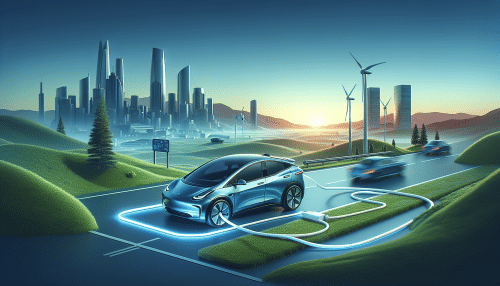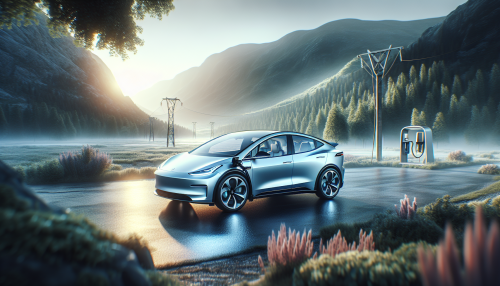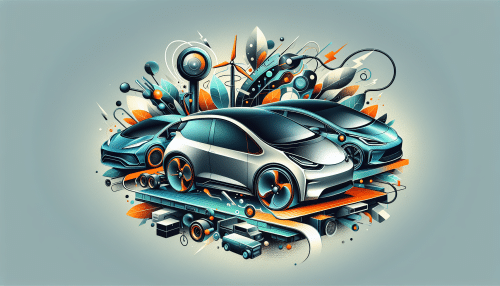Electric Cars and Your Commute
Brian Taylor November 16, 2025
Curious about whether switching to an electric car can truly change daily driving? This in-depth guide explores what makes electric vehicles unique, their real impact on commuting habits, maintenance benefits, and what to know before making a decision. Dive in to learn how this technology could reshape your experience on the road.
The Electric Car Revolution and Everyday Drivers
Electric vehicles, often called EVs, are quickly becoming a familiar sight on city streets and highways. Their innovative battery systems and quiet motors provide an alternative to traditional gasoline engines. Many people wonder if these vehicles can truly stand up to the demands of the daily commute. While some worry about charging times or range anxiety, current models have come a long way. The increasing presence of public charging stations and advances in battery life are helping to reshape perceptions of electric cars. Commuters are beginning to notice how a morning drive can feel smoother, cleaner, and more modern. The transition isn’t just about technology. It’s a cultural shift that spans everything from individual driving routines to how cities plan for the future (Source: https://afdc.energy.gov/files/u/publication/ev-basics.pdf).
Beyond the flashiness of electric car design, real-world data supports their impact. Studies reveal that a majority of commutes fall well within the average electric car driving range. With most modern EVs offering over 200 miles on a single charge, daily errands or office runs rarely challenge battery capacity. Drivers who adopt electric models often report enjoying a quieter, less stressful commute. One overlooked benefit is how instant torque allows smoother starts and quick lane changes in heavy city traffic. Even if home charging isn’t available, more companies and workplaces are adding charging options, blending convenience into existing routines.
Regulatory policy, consumer incentives, and a public push for greener alternatives have made electric vehicles accessible to a wider group. As infrastructure grows, drivers gain confidence in the reliability of these cars. Many discover that range limitations are rarely an issue, accepting a few minor changes like planning charging sessions during downtime. For city commuters and those with predictable daily routes, the lifestyle fit can be seamless. For others, the clarity comes through test drives or conversations with long-term EV owners. One thing is certain—electric cars are now a pragmatic, not just futuristic, choice.
Charging Electric Cars: Options and Expectations
Charging an electric car brings a new routine. For many, the main question is: where and how often? Home charging is convenient—a simple plug-in at night tops up most EVs. But even those without dedicated garage space are discovering new solutions. Public charging stations have expanded rapidly, especially in urban centers and along major travel corridors. These stations typically offer slower Level 2 charging or fast DC charging, letting drivers pick what suits their schedule.
Some shoppers wonder if public charging is expensive or complicated. The reality feels closer to using a smartphone charger in new places. Costs can vary based on station network or power levels, but many workplaces offer free or discounted access as an added perk. Charging networks often come with mobile apps that show availability, nearby spots, and even estimate how much time a session might take. This makes it easier for drivers to plan short stops during shopping or errands. The routine blends into modern lifestyles without dramatic disruption (Source: https://www.energy.gov/eere/vehicles/articles/fotw-1211-january-9-2023-average-us-daily-driving-distances-well-below-electric).
Fast charging is frequently used for longer road trips or urgent top-ups. Most drivers, though, rely on overnight home charging, which is affordable and convenient. Studies show that over 80% of electric vehicle charging happens at home. Those with access to workplace chargers can top up during the day and maximize daily range. While some early adopters felt anxiety about running out of charge, growing infrastructure and improved communication tools now make the process smoother and more predictable than many expect.
Cost Savings and Maintenance Differences
One of the most attractive aspects of owning an electric car is the lower cost of operation. Without gasoline fill-ups and with fewer moving parts, the savings add up. The typical EV driver spends less per mile on power than drivers of gasoline vehicles spend on fuel. Battery efficiency and regenerative braking not only stretch every dollar but also reduce brake wear. Maintenance routines skip oil changes, spark plugs, and exhaust checks. For many, the shift to less frequent servicing means fewer trips to the shop and more time spent on the road (Source: https://afdc.energy.gov/files/u/publication/ev-maintenance.pdf).
Upfront, electric cars may still cost more than a comparable gas vehicle. However, incentives and tax credits available in many regions can shrink this gap considerably. More importantly, the long-term savings in fuel and regular maintenance often outweigh the initial investment. Some studies suggest maintenance bills for electric vehicles can be 40% lower compared to traditional cars. As batteries last longer and charging hardware improves, the value proposition grows. For budget-conscious drivers, these differences increasingly make electric cars appealing beyond environmental reasons.
The simplicity of an electric drivetrain means fewer things can go wrong. Issues around transmission, coolant leaks, or muffler deterioration simply don’t apply. Battery health is a core concern, but advancements in technology are producing packs designed to last over 100,000 miles. As more used EVs enter the market, their reputation for reliability continues to develop. With fewer unexpected repair costs, electric vehicles may ease worries that hold some drivers back from making the leap.
Environmental Impact and Community Benefits
Electric vehicles promise a cleaner commute. Tailpipe emissions vanish when driving an EV, which means better air quality, especially in urban settings. Reduced noise pollution is another plus. Quiet motors make city streets less chaotic and neighborhoods more peaceful. The direct environmental effect is most obvious in areas with dense traffic, but even suburban drivers contribute to cleaner communities by choosing electric.
However, some question the true environmental impact given the need to produce batteries and generate electricity. Recent studies show that, even accounting for power generation, electric cars typically offer lower lifetime emissions compared to gasoline vehicles. As the power grid becomes cleaner with increased use of renewable energy sources, driving electric will only get greener. Several cities are investing in renewable power and creating eco-friendly charging infrastructure, helping to maximize these environmental benefits (Source: https://www.epa.gov/greenvehicles/electric-vehicle-myths).
Driving electric also supports broader shifts in transportation planning. Local governments and businesses are integrating EVs into shared fleets, delivery services, and even bus lines. Public investment in charging stations reflects a commitment to clean air and energy independence. Personal choices add up. Early adopters become ambassadors, demonstrating advantages to friends and family, and nudging neighborhoods toward cleaner living. Over time, these small community effects can reshape entire regions for the better.
Range Anxiety and Real-World Experience
Range anxiety was once a major barrier to electric car adoption. Fear of becoming stranded or unable to find a charge kept many from making the switch. Modern advancements have changed that. With most commuting distances well within average battery capacity, the majority of drivers rarely encounter limitations. Newer EVs can travel farther than many expect. Trip planning apps and dynamic route features further ease worries. Drivers soon realize that electric cars fit naturally into their existing routines.
Testimonials from EV owners help paint a realistic picture. Many say range anxiety fades within weeks as they adjust to monitoring battery levels and planning occasional charging breaks. Others appreciate that most charging is passive—simply plug in at home or work and forget about it until needed. The car’s onboard systems offer reminders, mileage estimates, and suggestions for nearby chargers. With more infrastructure in place, confidence rises.
Even for the occasional long road trip, new networks of high-speed chargers make travel simple. Families document adventure travels across the country in their electric vehicles, showing that technology can already support lifestyles beyond short city hops. While changes in planning are sometimes needed, the overwhelming experience is that electric cars are both dependable and enjoyable for a variety of uses. The shift is no longer experimental—it’s everyday practical (Source: https://www.consumerreports.org/cars/hybrids-evs/what-to-know-before-you-buy-an-electric-car-a1080274859/).
What to Know Before You Choose Electric
Selecting an electric car requires research and a shift in expectations. Charging availability, incentives, and insurance are factors to consider. Different cars provide different efficiency, seating, and connectivity features. Shopping for an EV often starts online with comparison tools and ends with a test drive to get a feel for the drive. Look into local charging infrastructure and neighbor feedback for a real-world view.
Buyers often ask about out-of-warranty repairs and resale value. As more brands enter the field, parts availability and service networks are expanding. Certified used programs from automakers add reassurance. While early EVs had unpredictable values, increased demand and longer battery warranties make resale more stable. Some brands offer transferable warranties for battery packs, providing additional peace of mind (Source: https://www.nrel.gov/docs/fy19osti/72260.pdf).
Incentive programs remain a helpful bonus. Many regions offer tax credits, rebates, or HOV lane access, making EV ownership more appealing. Dealerships often guide buyers through these options at purchase. Beyond cost savings, community resources and online owner groups provide a network for questions and troubleshooting. Ultimately, going electric means exploring new technology—but also joining a growing movement that’s already making a mark on daily life.
References
1. U.S. Department of Energy. (n.d.). Electric Vehicle Basics. Retrieved from https://afdc.energy.gov/files/u/publication/ev-basics.pdf
2. U.S. Department of Energy. (2023). Average U.S. Daily Driving Distances are Well Below Electric Vehicle Ranges. Retrieved from https://www.energy.gov/eere/vehicles/articles/fotw-1211-january-9-2023-average-us-daily-driving-distances-well-below-electric
3. U.S. Department of Energy. (n.d.). Maintaining Electric Vehicles. Retrieved from https://afdc.energy.gov/files/u/publication/ev-maintenance.pdf
4. U.S. Environmental Protection Agency. (n.d.). Electric Vehicle Myths. Retrieved from https://www.epa.gov/greenvehicles/electric-vehicle-myths
5. Consumer Reports. (n.d.). What to know before you buy an electric car. Retrieved from https://www.consumerreports.org/cars/hybrids-evs/what-to-know-before-you-buy-an-electric-car-a1080274859/
6. National Renewable Energy Laboratory. (2019). Electric Vehicle Batteries: Materials, Cost, Lifespan. Retrieved from https://www.nrel.gov/docs/fy19osti/72260.pdf





